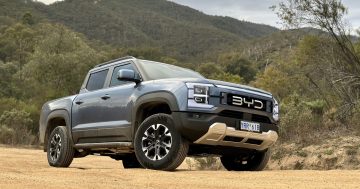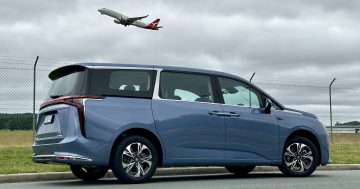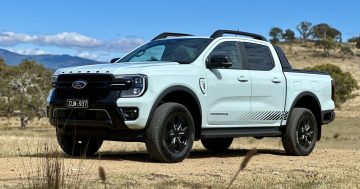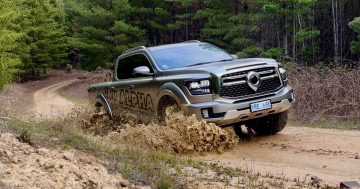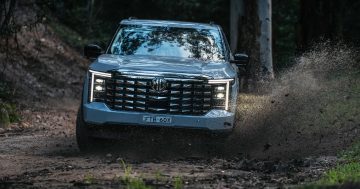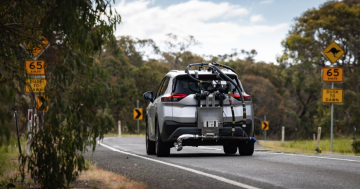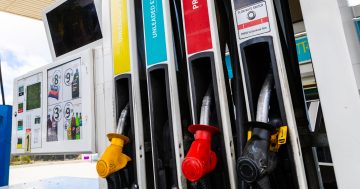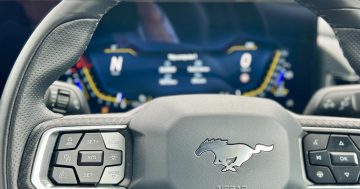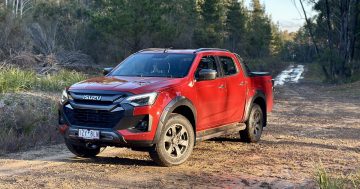James Purtill* says a new report has predicted that the environmentally friendly utes are about to boom in popularity.
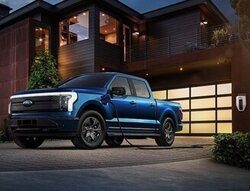 For years, Australians have been told that electric utes will never work. Either they’d “end the weekend” and sell poorly — or they simply did not exist.
For years, Australians have been told that electric utes will never work. Either they’d “end the weekend” and sell poorly — or they simply did not exist.
Now, the first models are being shipped.
By 2030, electric utes and vans will make up over half of light commercial vehicle sales in Australia, according to modelling published today by the management consultancy Boston Consulting Group (BCG).
By next year, the BCG report says, light commercial vehicles will be as cheap as their internal combustion engine (ICE) equivalents, based on total cost of ownership over the lifetime of the vehicle.
And as costs keep falling, they’ll get even cheaper.
Electric utes and vans are set to rapidly become the new vehicles of choice for builders, electricians and other tradies — so long as we can get enough of them shipped here, experts say.
So, are they right?
Are EVs about to win over Australia’s ute-loving tradies?
EV utes set to be cheaper than ICE equivalents
Late last month, the Chinese-owned car maker LDV announced it was shipping Australia’s first battery electric ute.
Ryan Thomas, fleet manager for the NSW and ACT transmission network operator Transgrid, has already ordered a batch of the LDV eT60 electric utes, due to arrive in December.
According to Mr Thomas, the Transgrid CEO recently asked if they could replace the fleet’s 400 diesel utes with electric ones by 2024.
“I said, ‘I don’t think so, but let me see.’”
Transgrid, like other companies, was under pressure from the board and shareholders to decarbonise, so the arrival of an electric ute option has been eagerly awaited, Mr Thomas said.
Added to this, EVs were significantly cheaper to run and service than ICE vehicles.
“We spend in the millions on diesel each year and close to the millions on repair and maintenance,” he said.
“The expected reduction in our fuel costs is probably close to 50 per cent over a diesel vehicle.”
Fleet managers base purchase decisions on total cost of ownership (TCO), which is the up-front cost of purchasing the vehicle added to the ongoing costs of fuel or electricity as well as maintenance.
At the moment, EVs tend to be more expensive to buy, but significantly cheaper to run and service.
The LDV eT60 is expected to cost about $20,000 more than the ICE equivalent T60.
By 2023, the TCO for EV utes and vans will be the same as for their ICE equivalents, based on the assumption they’ll be used for 10-15 years, said Anita Oh, a partner at BCG and a co-author of the report.
The main reason for this was falling battery costs, she said.
“Battery costs are roughly half the cost of the vehicle, and the cost of a battery pack should roughly halve by the end of the decade.”
The report predicts EVs will account for 55 per cent of new sales of light commercial vehicles (ie utes and vans) by 2030.
“Intra-city” light commercial vehicles, which account for the vast majority of tradie utes, make ideal candidates for electrification: they clock up enough kilometres that the reducing running costs becomes significant, but their daily journeys are short enough that range isn’t a factor.
Many are also part of fleets and can be charged at private depots rather than relying on public infrastructure.
“That’s why TCO parity is happening so soon,” Ms Oh said.
But do they have the range and power?
Roev, a startup that plans to build electric utes by retrofitting ICE models, has been looking carefully at the tradie ute market.
“There are over 1 million utes out there that are less than five years old,” said Noah Wasmer, the company’s CEO and co-founder.
“The dual-cab ute has almost become the family vehicle.”
Utes make up one-fifth of new vehicles sales in Australia and the best-selling models are routinely the most popular cars in the country.
According to Mr Wasmer, tradies drive about twice as much as the national average of 36km per day.
“And these are must-drive kilometres,” he said.
Mr Thomas agreed that commercial utes tend to get driven further than standard passenger cars: those in the Transgrid fleet did about about 100km-130km a day.
Modern electric utes have a range of about 300-400km fully charged.
Adding weight to the tray reduces the range, but not by too much.
Hitching a trailer has a more drastic effect — The LDV eT60’s 330km range is slashed by as much as 50 per cent when towing at its maximum capacity of 1,500kg.
So they can tow, but not that far before having to recharge.
“If you’re towing a huge water craft for hundreds of kilometres, an EV is not a great fit,” said Roev’s Noah Wasmer.
But about 90 per cent of the time utes weren’t being used for towing, he said.
“Electric utes should be suitable for the vast majority of use cases.”
“But if you want to go into the outback for weeks on end you’re probably still better with diesel.”
What tradies overseas are saying
Mitch Smedley, a plumber near Kansas City, Missouri, bought a Ford eTransit all-electric van late last year.
“At the time, I wasn’t for or against electric vehicles.
I was very neutral.”
“I wondered if it’ll have the power of gas vans and I wondered if I’d have range anxiety, because I’d heard alot about range anxiety.”
“But very quickly within month and a half of owning this thing all those fears were out the window.”
He averages 112km per day, or less than half the estimated driving range of 317km.
The running costs are significantly lower.
“We run on average 350 miles [563km] a week and my gas Transit would use anywhere from $US100-$US140 per week in fuel.”
“My eTransit costs $9 to recharge.”
Mr Smedley also uses the van’s battery like a portable generator to charge tools when he’s at work sites without power.
“I’ve had several jobs where I either string out several hundred feet of extension cords or drive my van to where the work is and then plug into my van,” he said.
David Crawford, an air-conditioner installer in North Carolina, bought a Ford F150 Lightning electric ute in July this year.
Because the electric motor takes up less space, there’s space to store tools in a compartment at the front of the car, called the “frunk” (front trunk).
“They’re much more secure than a toolbox,” he said.
In New Zealand, Ken Johnson manages an air-con installation business, Auckland Energy Solutions, which has recently invested in several LDV eDeliver electric vans.
“The advantage is they cost 4 cents a kilometre instead of 30c a kilometre,” he said.
Its fleet of 14 vehicles will be 100 per cent electric by 2024, Mr Johnson said.
“It costs us $NZ500 a month to run a van but the EV costs under $NZ100,” he said.
“So in my mind we’re saving $NZ5,000 per van a year.”
In the US and NZ there were also plenty of tradies who remained stubbornly opposed to the idea of electric utes and work vans.
Having EV options available hasn’t changed everyone’s minds overnight.
But the majority were just hesitant, not opposed, said Mitch Smedley in Missouri.
And they would be convinced by the savings calculations.
“We can save so much money going to EVs.”
Will enough EV utes get shipped here?
Demand may be strong, but supply could be an issue.
There was a growing global shortage of materials needed to produce electric cars, such as lithium, said BCG’s Anita Oh.
“We’re seeing the beginnings of a supply crunch on inputs,” she said.
“We think that will flow thorough in a material way from 2025 onwards.”
On top of this, Australia’s lack of fuel efficiency standards means car makers have been shipping their EVs to other markets, such as Europe and the US, which do have such standards.
“We won’t secure enough electric ute models without an ambitious fuel efficiency scheme,” said Jake Whitehead, had of policy at the Electric Vehicle Council.
“We need that fuel efficiency scheme in place.
“Very soon after that we’ll see more EV utes on the market.”
Late last month, the federal government released a National Electric Vehicle Strategy consultation paper, which included proposed “credible and robust” fuel efficiency standards.
“We’re starting to see initial signs manufacturers are reacting to the government talking about it,” Mr Whitehead said.
Almost all of Australia’s big-selling utes are made in Thailand.
That includes the Toyota HiLux, Ford Ranger, Mazda BT-50, Mitsubishi Triton, Holden Coloroado, Isuzu D-Max and Nissan Navara.
In July, Tony Weber, the CEO of the peak industry body representing car manufacturers and importers, the Federal Chamber of Automotive Industries (FCAI), said that manufacturers in Thailand “are not in a position to produce electric one-tonne utes”.
“Nor will they be in 2035,” he told the industry news site GoAuto.
Mr Whitehead said these comments were misleading.
Thailand has set a goal of selling only zero-emission vehicles from 2035 onwards and is investing heavily in incentives for EV producers.
“Thailand has pretty ambitious goals in terms of manufacturing EVs, including utes,” Mr Whitehead said.
In general, he said, the arguments against EV utes were running out of juice.
They’d evolved from “such utes don’t exist” to “they exist, but we can’t get them”.
“There’s so much misinformation out there,” he said.
“But it’s a little harder to refute that these vehicles exist when they’re coming into the country.”
*James Purtill works at triple j Hack in Sydney. Before that he was a digital producer at the ABC in Darwin.
This article first appeared at abc.net.au.


